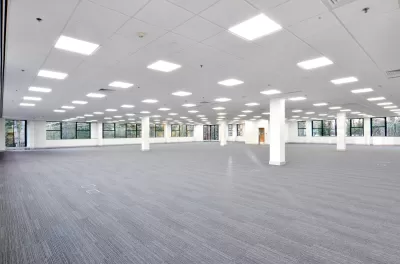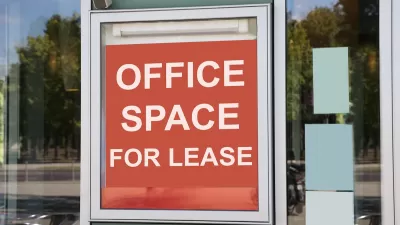Despite efforts on the part of many employers to bring workers back to the office, office buildings are now the most distressed segment of the commercial real estate market.

Move over, dead malls: there’s a new troubled kid in town. “According to a new report by MSCI Real Assets analyzing the commercial real-estate sector, around $24.8 billion of office buildings in the U.S. were in financial distress by the end of the second quarter — surpassing both retail (which includes malls) and hotels,” explains Clio Chang in Curbed.
“As remote work continues to force companies to cut back their real-estate footprints, the MSCI report showed that the measure of offices in distress was up by 36 percent since the first quarter. Meanwhile, the country’s overall office-vacancy rate is at 20 percent.”
While housing advocates tout office vacancies as an opportunity to convert these centrally located buildings to housing, it remains to be seen if that idea can overcome the costs and logistical challenges of adaptive reuse.
FULL STORY: Offices Are the New Malls

Americans May Be Stuck — But Why?
Americans are moving a lot less than they once did, and that is a problem. While Yoni Applebaum, in his highly-publicized article Stuck, gets the reasons badly wrong, it's still important to ask: why are we moving so much less than before?

Using Old Oil and Gas Wells for Green Energy Storage
Penn State researchers have found that repurposing abandoned oil and gas wells for geothermal-assisted compressed-air energy storage can boost efficiency, reduce environmental risks, and support clean energy and job transitions.

Placekeeping: Setting a New Precedent for City Planners
How a preservation-based approach to redevelopment and urban design can prevent displacement and honor legacy communities.

San Francisco’s Muni Ridership Grew in 2024
The system saw its highest ridership since before the Covid-19 pandemic, but faces a severe budget shortage in the coming year.

Colorado Lawmakers Move to Protect BRT Funding
In the face of potential federal funding cuts, CDOT leaders reasserted their commitment to planned bus rapid transit projects.

Safe Streets Funding in Jeopardy
The Trump administration is specifically targeting bike infrastructure and other road safety projects in its funding cuts.
Urban Design for Planners 1: Software Tools
This six-course series explores essential urban design concepts using open source software and equips planners with the tools they need to participate fully in the urban design process.
Planning for Universal Design
Learn the tools for implementing Universal Design in planning regulations.
Heyer Gruel & Associates PA
City of Moreno Valley
Institute for Housing and Urban Development Studies (IHS)
City of Grandview
Harvard GSD Executive Education
Salt Lake City
NYU Wagner Graduate School of Public Service
City of Cambridge, Maryland





























